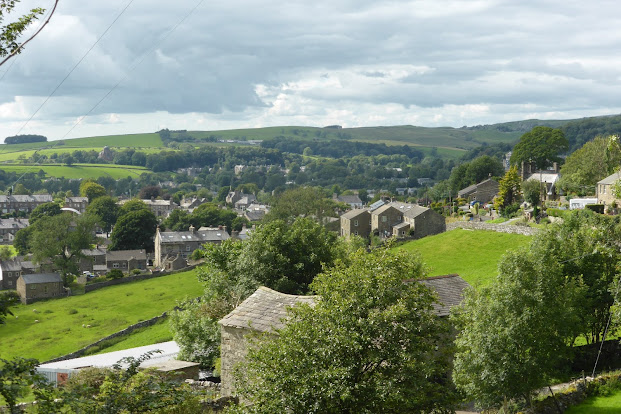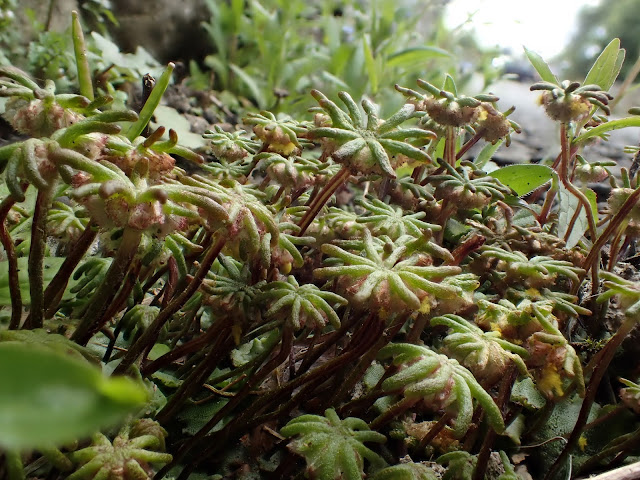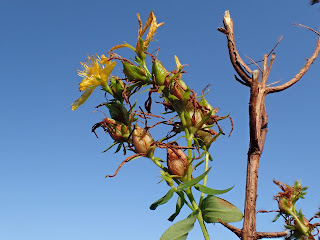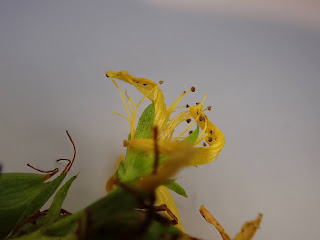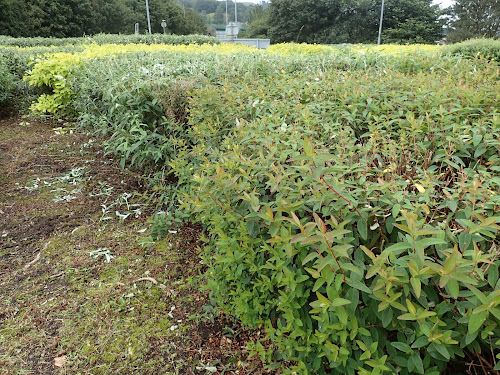Members of the family are easy to recognise because they have: - Opposite simple leaves with translucent or coloured glands.
- 5 yellow petals and numerous stamens grouped into bundles.
There is lots more about Hypericum and the Hyperaceae on wikipedia
But then it gets much harder working out which one is which.
Fortunately most of them flower relatively late in the year- July and August - so I don't have to worry about them till then. but "then" is now"
Here are the plants I have found near Settle:
1. Hypericum hirsutum: Hairy St John's-wort
which I found on 12 August in Lord's Pasture. It also grows at the Hoffmann Kiln. (29 August-almost over)
 |
Hairy St John's-wort at Lord's Pasture.
You can see from the leaves of plants nearby what a good field Lord's Pasture is. See Salad Burnet, Rock-rose, Bird's-foot trefoil, Lady's-mantle |
Hairy St John's-wort has a hairy stem and leaves. It has translucent holes in the blades and black dots along the edge of the sepals.
 |
Hairy St John's-wort leaf
|
2. Hypericum desertangsii,
I hereby declare that all the other common St John's-worts that we get around Settle are Hypericum desertangsii, which is a cross between
3. Imperforate St-John's-wort
Hypericum maculatum - ssp obtusiusculum.
and
4. Hypericum perforatum. Perforate St John's-wort
or else a back cross.
From the southend of the bypass to the north end, including at the Runlley Bridge and at Giggleswick Station there are this hypbrid, but it looks more like its like Hypericum maculatum - ssp obtusiusculum Imperforate St John's-wort parent.
The Hypericums along the bypass from the north end to the south end including at Giggleswick Station could be this hyprid.
The hybrid has sort of four ridges on the stem but two of them are much bigger than the others.
the sepals are relatively blunt - just slightly acute - and with a microscope the sepals have teeth.
Beside the bypass - at the south eastern junction with settle and on the path down to the river at the NW side of Runley Bridge there are plants of Imperforate St-John's-wort
It is rhizomatous, glabours perennial with tetraquetrous wingless stems. there are black glands on the leaves.
Hypericum maculatum - ssp obtusiusculum
It has black glands on the petals mainly as superficial lines.
Only the very top heaves have translucent spots in them.
The sepals are relatively blunt. With a microscope teeth can be seen on the sepals.
They are different to the plants found at the Hoffmann Kiln (See lower)
4. Perforate St John's-wort
Hoffmann Kiln Hypericums:
There are lots of Hairy St Johns'-worts - easy - hairy. (See above)
The other plant is much more delicate. All its leaves have translucent spots; The sepals are very acute and the teeth are bigger than in the bypass plants. It has two ridges on the stem
It could key out to the hyprid Hypericum desertangsii but it is different to the Bypass Plants
 |
You can see all the leaves have translucent spots
|
You can see the sepals are pointed. Under the microscope they had teeth.
----------------------------------------------------
5. Trailing St John's-wort - Hypericum humisiferum
This looks much different to the other St John's-worts. It is small and trails and grows on acid soils.
And is definitely what it is.
I actually found this in 16 July 2019 11/2 mile north of Rathmell - perhaps 1/2 mile outside my self-imposed limit of 2 miles radius of Settle - but it is so pretty I would like to include it. I found it with a group from the BSBI field week at Malham Tarn whilst we were surveying that monad.
 |
| Trailing St John's-wort - Hypericum humisiferum |
------------------------------------
6. Tutsan - H androsaemum
I found this on a limestone cliff near Stainforth 16 June, in a natural habitat. I have also seen it in Angela B's garden and in front of Edith D's Garden.
 |
Tutsan - cliff near Stainforth
|
 |
Tutsan - garden Upper Settle
|
 |
Tutsan - garden Upper Settle
|
-----------------------------------
7. Hypericum x inodorum - Tall Tutsan -
H androsaemum x H hircinum
This plant - a small shrub - grows at the Mill Pond at Langcliffe Mill. At least that is the name Mike Canaway gave it.
I examined them both this week.
They both do smell slightly and similar. I don't know what Goats smell like to say if that is what the smell it.
The Langciffe plant (inodorum) was taller 1.6m?. It had smaller petals c 12mm than the the river Ribble plant - and the stamens and styles were very long relative to the length of the petals. The stems could be said to have 2 ridges as required by the book.
However the styles were three times as long as the ovary which was a feature that should have been claimed by the hircinum. The leaves were slightly smaller and narrower than the hircinum. The bush flowered earlier |
Tall Tutusan
Hypericum inodum at Langcliffe Millpond 13 July 2020
|
 |
Hypericum inodorum Fruit and remaining flower 1 Sept
|
8. Hypericum hircinum Stinking Tutsan
 |
Stinking Tutsan, by the River Ribble South of Station Road in Settle
1 Sept 2020
The petals are larger than in H inodorum the stamen filaments are about the same length |
9. Hypericum pseudohenryi - Irish Tutsan?
Ah.
suggests:
9. Hypericum 'Hidcote'
from the orange anthers?
Yes it does indeed look like Hypericum x hidcoteense
more
This is planted on the Roundabout at the south end of the bypass.
it also grows in front of E.D's House on Stackhouse Lane.
 |
Hypericum x hidcote
|
-------------------------------------------







